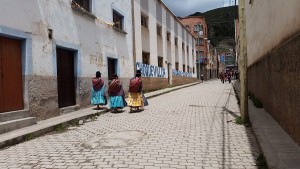 Questa cittadina si trova sulla baia del lago Titicaca a 158 km da La Paz, sta a 3800m di altezza. Anticamente era una regione mistica, un centro cerimoniale per i Tiwanacu e successivamente per gli Inka; ora e' una destinazione di pellegrinaggio dei devoti della Madonna nera di Copacabana.
Noi siamo arrivati nella settimana santa e abbiamo visto la città trasformarsi: da tranquilla e un po' turistica, a super affollata di fedeli accampati in tende per la strada, stand gastronomici e ludici ovunque.
Ci si e' presentata una situazione molto familiare come una sagra paesana italiana con banchetti pieni di giocattoli, zucchero filato e palloncini per i bambini. Tutto questo tra i mille colori delle gonne delle 'cholitas' (donne boliviane con cappello a bombetta e gonne vistose) e i tanti bimbi imbacuccatissimi in strati e strati di lana.
Alla fine siamo rimasti tre giorni a Copacabana per riposarci un po' e per decidere sulle mosse future.
Questa cittadina si trova sulla baia del lago Titicaca a 158 km da La Paz, sta a 3800m di altezza. Anticamente era una regione mistica, un centro cerimoniale per i Tiwanacu e successivamente per gli Inka; ora e' una destinazione di pellegrinaggio dei devoti della Madonna nera di Copacabana.
Noi siamo arrivati nella settimana santa e abbiamo visto la città trasformarsi: da tranquilla e un po' turistica, a super affollata di fedeli accampati in tende per la strada, stand gastronomici e ludici ovunque.
Ci si e' presentata una situazione molto familiare come una sagra paesana italiana con banchetti pieni di giocattoli, zucchero filato e palloncini per i bambini. Tutto questo tra i mille colori delle gonne delle 'cholitas' (donne boliviane con cappello a bombetta e gonne vistose) e i tanti bimbi imbacuccatissimi in strati e strati di lana.
Alla fine siamo rimasti tre giorni a Copacabana per riposarci un po' e per decidere sulle mosse future.
 Abbiamo fatto una passeggiata al Calvario, che e' un monte che arriva fino ai 4000m e si affaccia sulla baia; e' un luogo di pellegrinaggio e processioni: per il venerdì santo era programmata una processione per raggiungere la cima alle 6e30 di mattina, tra preghiere e rosari. Noi siamo andati per curiosità e per la vista, da li si poteva vedere tutta la baia con una visuale incredibile sul lago Titicaca.
Intorno a Copa ci sono diversi siti archeologici della civilta' Inka, noi abbiamo deciso di andare all'isola del Sol abitata anticamente dai Tiwanacu e luogo di origine della popolazione Inka.
Isola Del Sol
Per visitare tutta l'isola abbiamo preferito prendere una barca per il nord e tornare dal sud, attraversando tutta l'isola a piedi percorrendo cosi più di 10 km.
Abbiamo fatto una passeggiata al Calvario, che e' un monte che arriva fino ai 4000m e si affaccia sulla baia; e' un luogo di pellegrinaggio e processioni: per il venerdì santo era programmata una processione per raggiungere la cima alle 6e30 di mattina, tra preghiere e rosari. Noi siamo andati per curiosità e per la vista, da li si poteva vedere tutta la baia con una visuale incredibile sul lago Titicaca.
Intorno a Copa ci sono diversi siti archeologici della civilta' Inka, noi abbiamo deciso di andare all'isola del Sol abitata anticamente dai Tiwanacu e luogo di origine della popolazione Inka.
Isola Del Sol
Per visitare tutta l'isola abbiamo preferito prendere una barca per il nord e tornare dal sud, attraversando tutta l'isola a piedi percorrendo cosi più di 10 km.
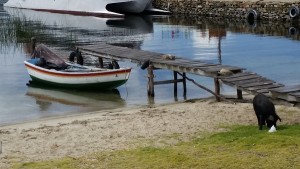 Siamo sbarcati a Chullapampa uno dei tre paesini autonomi dell'isola. In totale ci sono 2.500 persone, che sono auto sufficienti poiché vivono di turismo e di ciò che coltivano e pescano.
La rotazione delle colture di quinoa, mais, fave, carote e altro viene seriamente rispettata come anche i 7 anni di riposo per i terreni. Hanno dei sistemi a terrazza con cui cercano di proteggere le coltivazioni dal vento e dal freddo. Le terrazze si chiamano 'pata pata' in lingua Aymara, e venivano inizialmente utilizzate per coltivare le patate, prodotto fondamentale per l'alimentazione boliviana e anche peruviana: ne hanno più di 2000 tipi diversi.
Siamo sbarcati a Chullapampa uno dei tre paesini autonomi dell'isola. In totale ci sono 2.500 persone, che sono auto sufficienti poiché vivono di turismo e di ciò che coltivano e pescano.
La rotazione delle colture di quinoa, mais, fave, carote e altro viene seriamente rispettata come anche i 7 anni di riposo per i terreni. Hanno dei sistemi a terrazza con cui cercano di proteggere le coltivazioni dal vento e dal freddo. Le terrazze si chiamano 'pata pata' in lingua Aymara, e venivano inizialmente utilizzate per coltivare le patate, prodotto fondamentale per l'alimentazione boliviana e anche peruviana: ne hanno più di 2000 tipi diversi.
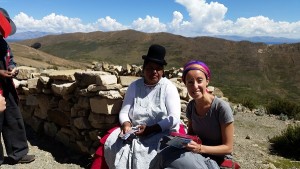 Apparentemente la gente di qui vive oltre i 100 anni, per la vita tranquilla, l'esercizio quotidiano tra pesca e la campagna e il cibo genuino. Aggiungiamo anche che questi vivono a stress 0.
Incredibile qui abbiamo trovato tanti alberi di eucalipto, apparentemente introdotti dall'Australia per la prevenzione delle frane e mantenimento del suolo.
Nella nostra passeggiata sembrava di essere a casa tra gli eucalipti e due compagne di viaggio di Perth, ma con qualche grado in meno.
Davanti all'isola nella zona nord ci sono altre piccole isole che formano un triangolo e proprio nel mezzo di questo c'è l'isola di Marcapampa, un'isola sommersa scoperta da Jean Coustau' nel 1968. Apparentemente già a 2 metri di profondità si può vedere un tempio Tiwanacu, che si espande per i 12 metri sottostanti.
Originariamente i Tiwanacu e anche gli Inka costruirono sul fondo del lago Titicaca, che aveva un livello dell'acqua decisamente basso rispetto ad oggi.
Apparentemente la gente di qui vive oltre i 100 anni, per la vita tranquilla, l'esercizio quotidiano tra pesca e la campagna e il cibo genuino. Aggiungiamo anche che questi vivono a stress 0.
Incredibile qui abbiamo trovato tanti alberi di eucalipto, apparentemente introdotti dall'Australia per la prevenzione delle frane e mantenimento del suolo.
Nella nostra passeggiata sembrava di essere a casa tra gli eucalipti e due compagne di viaggio di Perth, ma con qualche grado in meno.
Davanti all'isola nella zona nord ci sono altre piccole isole che formano un triangolo e proprio nel mezzo di questo c'è l'isola di Marcapampa, un'isola sommersa scoperta da Jean Coustau' nel 1968. Apparentemente già a 2 metri di profondità si può vedere un tempio Tiwanacu, che si espande per i 12 metri sottostanti.
Originariamente i Tiwanacu e anche gli Inka costruirono sul fondo del lago Titicaca, che aveva un livello dell'acqua decisamente basso rispetto ad oggi.
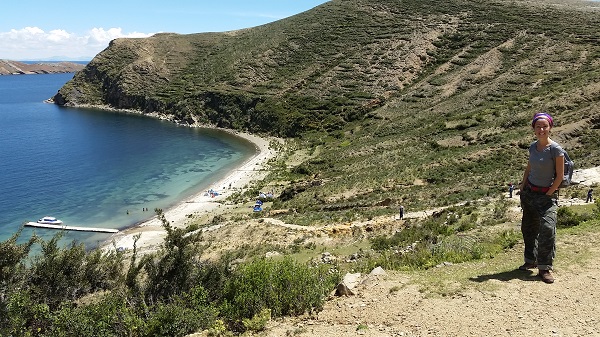 Al nord dell'isola si trova il Tempio del sol con il labirinto e la tavola dei sacrifici, davanti a quella che viene considerata una roccia sacra.
Parto dalla tavola dei sacrifici che ci ha impressionato più di tutto: qui ovviamente si facevano sacrifici propiziatori per gli dei e cerimonie religiose. Ci hanno spiegato che anche oggi la zona e' utilizzata a questi scopi: precisamente il 21 giugno c'e' una cerimonia per celebrare il nuovo anno andino, ad agosto ci sono tre cerimonie per la Pachamama, ad ottobre c'e' la festa delle patate per una produzione florida e a novembre sacrificano i cuccioli di llama come cerimonia propiziatoria per la produzione agricola.
E' proprio qui dicono siano nati i due fondatori della civiltà Inka: Mamaochio, Lei, e Mancucapa, Lui, successivamente spostatisi a Cuzco.
Al nord dell'isola si trova il Tempio del sol con il labirinto e la tavola dei sacrifici, davanti a quella che viene considerata una roccia sacra.
Parto dalla tavola dei sacrifici che ci ha impressionato più di tutto: qui ovviamente si facevano sacrifici propiziatori per gli dei e cerimonie religiose. Ci hanno spiegato che anche oggi la zona e' utilizzata a questi scopi: precisamente il 21 giugno c'e' una cerimonia per celebrare il nuovo anno andino, ad agosto ci sono tre cerimonie per la Pachamama, ad ottobre c'e' la festa delle patate per una produzione florida e a novembre sacrificano i cuccioli di llama come cerimonia propiziatoria per la produzione agricola.
E' proprio qui dicono siano nati i due fondatori della civiltà Inka: Mamaochio, Lei, e Mancucapa, Lui, successivamente spostatisi a Cuzco.
 La 'rocca sagrada' davanti alla tavola dei sacrifici e' anche oggi un luogo di pellegrinaggio dove i boliviani vanno per connettersi con la terra, semplicemente toccando questa roccia che ha le sembianze di un puma. Anche Evo Morales, il presidente boliviano in carica, e' andato questo anno il 21 di giugno per 'ricaricarsi'.
Noi l'abbiamo toccata e non abbiamo 'sentito' nessuna vibrazione magnetica ma possiamo assicurare che e' un luogo suggestivo.
Il tempio del sol aveva una 'cincana' (labirinto in lingua Quechua) che portava alla terra ferma addirittura fino a Cuzco. Solo i sacerdoti ne erano a conoscenza mentre gli altri credevano alle doti magiche dei sacerdoti che riuscivano a scomparire e apparire improvvisamente.
All'interno del tempio c'è una fonte d'acqua conosciuta come la fonte di giovinezza: ovviamente noi ne abbiamo bevuto un bel sorso, sfidando i microbi e il mal di pancia che ne poteva derivare e sperando che funzioni. 🙂
Curiosità:
Quest'isola era abitata dalle ancelle vergini, le giovani donne Inka più belle ed eleganti che avevano il compito di accudire il tempio e preparare una bevanda dolce fermentata con i cereali. I giovani Inka che volevano sposarsi andavano sull'isola per scegliere la sposa, ma solo dopo 7 giorni di purificazione a Copacabana.
La 'rocca sagrada' davanti alla tavola dei sacrifici e' anche oggi un luogo di pellegrinaggio dove i boliviani vanno per connettersi con la terra, semplicemente toccando questa roccia che ha le sembianze di un puma. Anche Evo Morales, il presidente boliviano in carica, e' andato questo anno il 21 di giugno per 'ricaricarsi'.
Noi l'abbiamo toccata e non abbiamo 'sentito' nessuna vibrazione magnetica ma possiamo assicurare che e' un luogo suggestivo.
Il tempio del sol aveva una 'cincana' (labirinto in lingua Quechua) che portava alla terra ferma addirittura fino a Cuzco. Solo i sacerdoti ne erano a conoscenza mentre gli altri credevano alle doti magiche dei sacerdoti che riuscivano a scomparire e apparire improvvisamente.
All'interno del tempio c'è una fonte d'acqua conosciuta come la fonte di giovinezza: ovviamente noi ne abbiamo bevuto un bel sorso, sfidando i microbi e il mal di pancia che ne poteva derivare e sperando che funzioni. 🙂
Curiosità:
Quest'isola era abitata dalle ancelle vergini, le giovani donne Inka più belle ed eleganti che avevano il compito di accudire il tempio e preparare una bevanda dolce fermentata con i cereali. I giovani Inka che volevano sposarsi andavano sull'isola per scegliere la sposa, ma solo dopo 7 giorni di purificazione a Copacabana.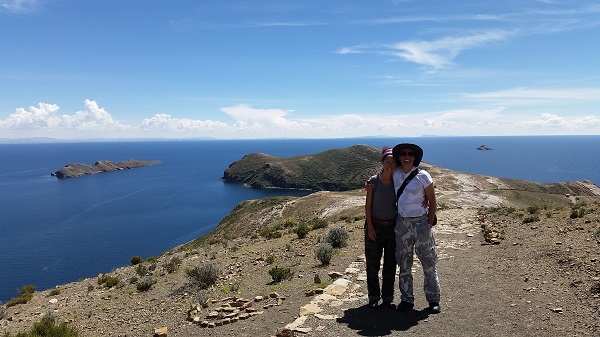 L'isola e' sicuramente un posto faticoso, sempre assolato e montuoso, dove non circolano macchine e tanto meno cavalli per il trasporto di persone e merci. Gli uomini si caricano tutto a spalla percorrendo l'isola in lungo e largo.
Abbiamo sentito un'energia particolare, forse ci siamo fatti suggestionare dai racconti e leggende, ma l'isola e le sue comunità ci hanno affascinati ed incuriositi.
L'isola e' sicuramente un posto faticoso, sempre assolato e montuoso, dove non circolano macchine e tanto meno cavalli per il trasporto di persone e merci. Gli uomini si caricano tutto a spalla percorrendo l'isola in lungo e largo.
Abbiamo sentito un'energia particolare, forse ci siamo fatti suggestionare dai racconti e leggende, ma l'isola e le sue comunità ci hanno affascinati ed incuriositi.
Bolivia – Copacabana e Isla del Sol First of all, finding out that there is another Copacabana, beside the Brazilian one, was a surprise.
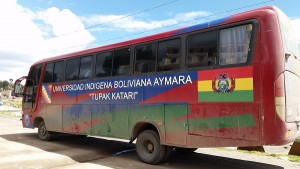 This town is located on the bay of Lake Titicaca at 158 km from La Paz, it is at 3800m high. Formerly it is a mystical region: it was a ceremonial center for the Tiwanaku and subsequently for the Inka; now it is a destination of pilgrimage for devotees of the Black Virgin of Copacabana.
We arrived in the holy week and we saw the city transformed: from a quiet and a bit tourist place, to a super crowded centre with faithful believers camped in tents on the streets, with food and games stands everywhere.
It presented a very familiar situation like an Italian sagra where there are standers full of toys, candies and balloons for children. The only difference was that all of this was really colourful with the skirts of the 'cholitas' (Bolivian women with bowler hat and showy skirts) and many children covered in layers and layers of wool.
This town is located on the bay of Lake Titicaca at 158 km from La Paz, it is at 3800m high. Formerly it is a mystical region: it was a ceremonial center for the Tiwanaku and subsequently for the Inka; now it is a destination of pilgrimage for devotees of the Black Virgin of Copacabana.
We arrived in the holy week and we saw the city transformed: from a quiet and a bit tourist place, to a super crowded centre with faithful believers camped in tents on the streets, with food and games stands everywhere.
It presented a very familiar situation like an Italian sagra where there are standers full of toys, candies and balloons for children. The only difference was that all of this was really colourful with the skirts of the 'cholitas' (Bolivian women with bowler hat and showy skirts) and many children covered in layers and layers of wool.
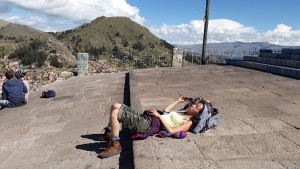 In the end, we stayed three days in Copacabana to rest a bit and to decide on the next steps.
We took a walk to Calvary, which is a mountain that reaches up to 4000m and overlooks the bay; it is a place of pilgrimage and processions: for the Good Friday a procession was scheduled to reach the top at 6.30am, between prayers and rosaries.
We went up there for curiosity and for the view: from there you could see the whole bay with a stunning view of Lake Titicaca.
Around Copa, there are several archaeological sites of the Inka civilization; we decided to go to the island of Sol inhabited by the ancient Tiwanaku and the place of origin of the Inka population.
Isla del Sol
To visit the island, we preferred to catch a boat to the North and return from the South, crossing the whole island on foot along well over 10 km.
In the end, we stayed three days in Copacabana to rest a bit and to decide on the next steps.
We took a walk to Calvary, which is a mountain that reaches up to 4000m and overlooks the bay; it is a place of pilgrimage and processions: for the Good Friday a procession was scheduled to reach the top at 6.30am, between prayers and rosaries.
We went up there for curiosity and for the view: from there you could see the whole bay with a stunning view of Lake Titicaca.
Around Copa, there are several archaeological sites of the Inka civilization; we decided to go to the island of Sol inhabited by the ancient Tiwanaku and the place of origin of the Inka population.
Isla del Sol
To visit the island, we preferred to catch a boat to the North and return from the South, crossing the whole island on foot along well over 10 km.
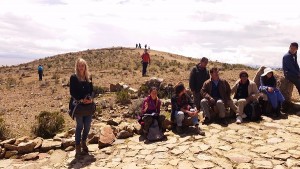 We landed in one of the three autonomous villages of the island, Chullapampa. In total there are 2,500 people, who are self sufficient as they live off tourism and what they farm and fish.
Crop rotation of quinoa, corn, beans, carrots, and more is seriously respected as well as the seven years of rest for the land. They cultivate in terrace, with which they try to protect crops from wind and cold.
The terraces are called 'pata pata' in Aymara language, and these were initially used to grow potatoes, essential product for Bolivian and Peruvian sustainability: they have more than 2000 different types.
We landed in one of the three autonomous villages of the island, Chullapampa. In total there are 2,500 people, who are self sufficient as they live off tourism and what they farm and fish.
Crop rotation of quinoa, corn, beans, carrots, and more is seriously respected as well as the seven years of rest for the land. They cultivate in terrace, with which they try to protect crops from wind and cold.
The terraces are called 'pata pata' in Aymara language, and these were initially used to grow potatoes, essential product for Bolivian and Peruvian sustainability: they have more than 2000 different types.
 Apparently the people here live more than 100 years, thank to the quiet life, daily exercise between fisheries, the cultivation and the genuine food. We can also add that those have a stress-free life.
Here we found many eucalyptus trees, apparently introduced from Australia for the prevention of landslides and for soil conservation.
In our walk, we felt at home among the eucalyptus trees and two traveling buddies coming from Perth, but with some degree less.
In front of the island in the North, there are other small islands that form a triangle and right in the middle of this there is the island of Marcapampa, a submerged island, discovered by Jean Cousteau in 1968. Apparently already at 2 meters deep, it can be seen a temple of the Tiwanaku, which expands to 12 meters below.
Originally the Tiwanaku and even the Inka built on the bottom of Lake Titicaca, which had a very low water level than today.
To the north of the island there is the Temple of the Sun with the labyrinth and the table of sacrifices, in front of that there is the sacred rock.
Apparently the people here live more than 100 years, thank to the quiet life, daily exercise between fisheries, the cultivation and the genuine food. We can also add that those have a stress-free life.
Here we found many eucalyptus trees, apparently introduced from Australia for the prevention of landslides and for soil conservation.
In our walk, we felt at home among the eucalyptus trees and two traveling buddies coming from Perth, but with some degree less.
In front of the island in the North, there are other small islands that form a triangle and right in the middle of this there is the island of Marcapampa, a submerged island, discovered by Jean Cousteau in 1968. Apparently already at 2 meters deep, it can be seen a temple of the Tiwanaku, which expands to 12 meters below.
Originally the Tiwanaku and even the Inka built on the bottom of Lake Titicaca, which had a very low water level than today.
To the north of the island there is the Temple of the Sun with the labyrinth and the table of sacrifices, in front of that there is the sacred rock.
 I start from the table of the sacrifices that impressed us most of all: here obviously they made sacrifices to propitiate the gods and religious ceremonies. They explained that even today the area is used for these purposes: namely in June on the 21st there is a ceremony to celebrate the Andean New Year, in August there are three ceremonies for the Pachamama, in October there is the potatoes celebration for a abundant production and in November, they sacrifice the baby llama as propitiatory ceremony for agricultural production.
Also, here the two founders of the Inka civilization were born: Mamaochio, She, and Mancucapa, He, then they moved to Cuzco.
I start from the table of the sacrifices that impressed us most of all: here obviously they made sacrifices to propitiate the gods and religious ceremonies. They explained that even today the area is used for these purposes: namely in June on the 21st there is a ceremony to celebrate the Andean New Year, in August there are three ceremonies for the Pachamama, in October there is the potatoes celebration for a abundant production and in November, they sacrifice the baby llama as propitiatory ceremony for agricultural production.
Also, here the two founders of the Inka civilization were born: Mamaochio, She, and Mancucapa, He, then they moved to Cuzco.
 The 'holy rock' is right in front of the table of sacrifices and even now is a place of pilgrimage, where Bolivians go to connect with the Earth, just touching this rock that has the shape of a puma. Even Evo Morales, the Bolivian president in charge, came this year in June to 'recharge'. We touched without feeling the magnetic vibration, but we can ensure that it is a charming place.
The temple of the sun had a 'cincana' (labyrinth in the Quechua language) that led to the mainland even up to Cuzco. Only the priests knew about it, while others believed on the magical qualities of the priests who could suddenly appear and disappear.
Inside the temple there was/is a water source known as the fountain of youth: of course we did drank a long draft, defying microbes and a stomach ache that could arise and hoping that it works. 🙂
Curiosity:
This island was inhabited by the virgin women of Inka, the most beautiful and elegant girls that had the task of looking after the temple and prepare a sweet drink with fermented grains. Young Inka men who wanted to get married, used to go to the island to choose the bride, but only after 7 days of purification in Copacabana.
The 'holy rock' is right in front of the table of sacrifices and even now is a place of pilgrimage, where Bolivians go to connect with the Earth, just touching this rock that has the shape of a puma. Even Evo Morales, the Bolivian president in charge, came this year in June to 'recharge'. We touched without feeling the magnetic vibration, but we can ensure that it is a charming place.
The temple of the sun had a 'cincana' (labyrinth in the Quechua language) that led to the mainland even up to Cuzco. Only the priests knew about it, while others believed on the magical qualities of the priests who could suddenly appear and disappear.
Inside the temple there was/is a water source known as the fountain of youth: of course we did drank a long draft, defying microbes and a stomach ache that could arise and hoping that it works. 🙂
Curiosity:
This island was inhabited by the virgin women of Inka, the most beautiful and elegant girls that had the task of looking after the temple and prepare a sweet drink with fermented grains. Young Inka men who wanted to get married, used to go to the island to choose the bride, but only after 7 days of purification in Copacabana.
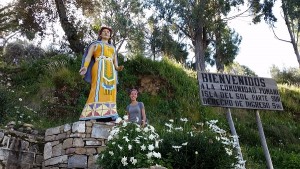 The island is definitely a tiring place, always sunny and mountainous, where there are no cars or even horses for transportation of people and goods. The men carry everything on shoulder far and wide along the island.
We felt a particular energy, maybe we have been influenced from the tales and legends, but the island and its communities are really fascinating and intriguing.
The island is definitely a tiring place, always sunny and mountainous, where there are no cars or even horses for transportation of people and goods. The men carry everything on shoulder far and wide along the island.
We felt a particular energy, maybe we have been influenced from the tales and legends, but the island and its communities are really fascinating and intriguing. 